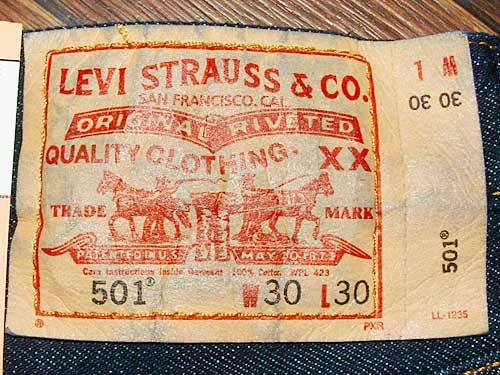BA1 CLASS VISUALS - INTRODUCTION TO FASHION THEORY - TRICKLE-DOWN/BUBBLE-(TRICKLE)-UP (JEANS)
KEY TERMS
None - this is an easy one!
None - this is an easy one!
1. The double heritage of the terms denim and jeans and the expansion of the term jeans to include not just the fabric but the garment. (Are there any other examples of this?) ...
2. The 501 red tag as a brand symbol. (What other examples are there of this?) ...
3. The adoption of trousers by women during World War 2 ...
4. The adoption of jeans by artistic communities and youth ...
5. The development of style and fashion in jeans ...
2. The 501 red tag as a brand symbol. (What other examples are there of this?) ...
3. The adoption of trousers by women during World War 2 ...
4. The adoption of jeans by artistic communities and youth ...
5. The development of style and fashion in jeans ...
1. The double heritage of the terms denim and jeans and the expansion of the term jeans to include not just the fabric but the garment. (Are there any other examples of this?) ...
Jeans had two precursors. One was the pants made of denim, a cotton-wool blend manufactured in Nimes, in the south of France. The other was a fustian fabric of cotton, wool, and/or silk produced in Genoa, Italy, around the same time. The word 'denim' came from Nimes, while 'jeans' came from Genoa...
The figure usually credited with the rise of jeans is Levi Strauss (1829-1902), who started up a dry-goods supply house in the early 1850s. From the start, he retailed durable denim work pants. Around this time, the term 'jeans' shifted from a descriptor for the fabric to the name of the style of pants: jeans were born!
(Craik, 2009, p.124).
Fleece!
2. The 501 red tag as a brand symbol. (What other examples are there of this?) ...
Levi Strauss added the leather tag bearing his name to the rear in 1886, created the signature 501 style in 1890, and added the red tab to the seat in 1936. These have remained key brand symbols ... (Craik, 2009, p.124).
3. The adoption of trousers by women during World War 2 ...
Although jeans were largely identified with male culture, women's involvement in the workforce in World War 11 saw the adoption of denim in their factory work clothes ... Postwar, most respectable girls eschewed jeans for skirts or tailored trousers. Most American universities banned jeans on campus well into the 1960s and 1970s, especially for women. (Craik, 2009, p.125).
4. The adoption of jeans by artistic communities and youth ...
Jeans, however, were adopted by artistic communities as a statement of an alternative lifestyle. Jack Kerouac's classic book 'On the Road' (1957) was reportedly responsible for selling a million pairs of jeans. (Craik, 2009, p.125).
Jack Kerouac's On the Road (first published 1957) book cover 2000
http://www.penguin.co.uk/nf/Book/BookDisplay/0,,9780141182674,00.html#
http://www.penguin.co.uk/nf/Book/BookDisplay/0,,9780141182674,00.html#
James Dean in Rebel Without a Cause 1955
en.wikipedia.org/wiki/James_Dean#mediaviewer/File-James_Dean_in_Rebel_Without_a_Cause
en.wikipedia.org/wiki/James_Dean#mediaviewer/File-James_Dean_in_Rebel_Without_a_Cause
...I'm smoking a fag as if I'm James Dean while walking along listening to Blank Space' (Duckels, 2014).
5. The development of style and fashion in jeans ...
Increasingly, consumers were looking for more stylish jeans than the standard workingman's jeans, and the main brands (Levi Strauss, Lee, Wrangler, and Cooper) were being pushed to develop new denim looks that complemented new youth fashions. (Craik, 2009, p.125).
Cocktail jeans 2011
http-//www.theguardian.com/lifeandstyle/gallery/2011/aug/23/cocktail-jeans-high-street
http-//www.theguardian.com/lifeandstyle/gallery/2011/aug/23/cocktail-jeans-high-street
REFERENCE
Craik, J. (2009) Fashion - the key concepts. Oxford: Berg.
Duckels, G. (2014) Twitter. Available at http://twitter.com/iamgabriel (Accessed 11 November 2014).
Craik, J. (2009) Fashion - the key concepts. Oxford: Berg.
Duckels, G. (2014) Twitter. Available at http://twitter.com/iamgabriel (Accessed 11 November 2014).
See also ...









